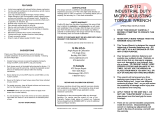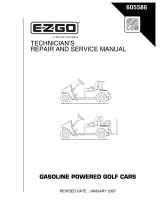Page is loading ...

MODEL H8000/H8001
INDUSTRIAL
TORQUE WRENCH
INSTRUCTION SHEET
COPYRIGHT © AUGUST, 2006 BY GRIZZLY INDUSTRIAL, INC.
WARNING: NO PORTION OF THIS MANUAL MAY BE
REPRODUCED IN ANY SHAPE OR FORM WITHOUT THE WRITTEN
APPROVAL OF GRIZZLY INDUSTRIAL, INC.
#TR8543 PRINTED IN CHINA
Using Extensions
Depending on the type of extensions used, you may
need compensate for added leverage by using a
lower torque setting to reach the true torque setting
applied to the fastener.
Note:
Compensation is only needed if the total
length of the torque wrench is extended. Typical
socket extensions that remain perpendicular to the
ratchet head do not change the length of the torque
wrench, and therefore, do not change the torque
applied to the fastener.
Typical Fastener Torque Settings
The charts below offer average torque recommen-
dations for different fastener sizes. Exact torque
settings are defined by fastener material type and
plating, lubrication, surface finish, and whether or
not the parts being fastened have gasketed joints.
Always follow the manufacturer’s torque recommen-
dations for your particular fasteners. Regardless of
any torque recommendations, NEVER exceed the
maximum torque setting on your wrench.
Material/Grade
Bolt Size
SAE 2
A307
SAE 5
A325
SAE 8
A354
1/4-20 6 10 12
5/16-18 12 20 25
3/8-16 22 38 50
7/16-14 36 55 85
1/2-13 58 85 125
9/16-12 80 125 175
5/8-11 112 175 245
3/4-10 180 300 425
Inch Fastener Torque Settings in Foot Pounds
Material/Grade
Bolt Size
CLASS 4.8 CLASS 8.8 CLASS 10.9
M5-0.8 3 5 8
M6-1 4 9 13
M8-1.25 12 22 32
M10-1.5 24 44 63
M12-1.75 41 76 111
M14-2 66 123 177
M16-2 103 199 280
M20-2.5 131 258 354
Metric Fastener Torque Settings in Foot Pounds
Certification
Before shipment, this torque wrench was calibrated
to an accuracy of +/- 4% in the clockwise direction.
Thank you for choosing Grizzly!

Introduction
Use this wrench to tighten fasteners (nuts, bolts, etc.) to
specific torque settings.
During operation, when the preset torque is reached, the
torque wrench will "click" to indicate that tensioning is
finished and no more pressure should be applied.
This model features a 45-tooth reversible ratchet that
has the capability to torque both left and right handed
fasteners.
This model is built with hardened alloy and rubber grips
for long-term industrial use; however, as with all torque
wrenches, the internal mechanisms can be damaged if
the wrench is used or stored improperly.
To keep your torque wrench working accurately, we
strongly recommend that you carefully follow the
Operation Tips and Torque Wrench Care on this
sheet.
Typical Usage
1. Unlock the handle, set the desired torque, and lock
the handle.
2. Attach a socket and set the ratchet direction.
3. Hold only the handle of the wrench and tighten the
fastener slowly until the wrench clicks, then stop
applying pressure (continued pressure may dam
-
age the torque wrench internal components).
4. Repeat as necessary with the remaining fasteners.
5. After using the wrench, unlock and turn the handle
to the lowest setting for storage. (Don’t adjust the
setting lower than the minimum torque setting or
you may damage the wrench.)
Operation Tips
• Hold the torque wrench only by the center of the
handle when tightening fasteners. Try to keep your
forearm perpendicular to the wrench when applying
pressure. Holding the torque wrench incorrectly will
result in inaccurate final torque tensions.
• Tighten fasteners in a slow and controlled manner,
and stop applying pressure immediately after the
torque wrench clicks. Using the torque wrench in
a hurried or jerky manner may result in inaccurate
final torque tensions.
• Lock the handle after setting the torque so it does
not change the setting during use.
• If using extensions, refer to the back of this page
for important formulas that will help you avoid over-
torquing your work.
• Fastener threads should be clean and free of any
dirt or grime. Dirty threads create excessive fric
-
tion during tensioning and cause the torque wrench
to click before it reaches the true torque. A small
amount of lubricant placed on the threads is typi
-
cally recommended for consistent results.
• When tightening many fasteners that hold a single
part, torque the fasteners in a criss-cross manner in
multiple passes that incrementally work up to 100%
of the desired torque. For example, on the first pass
tighten the fasteners 60% of the final torque, then
80% on the next pass, and 100% on the final pass.
This procedure will provide even, consistent results
on the final tension of all the fasteners.
• Avoid torquing fasteners that are already tightened
or that have been overtightened. Instead, loosen
them first, then apply the desired torque. Never use
the torque wrench to loosen fasteners.
Torque Wrench Care
• Avoid cheater bars or extension pipes. Using these
items on the back of the torque wrench, or using the
torque wrench as a breaker bar or pry bar, will ruin
the delicate parts inside the wrench and void the
warranty.
• Always store the torque wrench at the lowest setting
or the springs will lose their memory and make the
wrench inaccurate. However, never force the torque
setting below the lowest setting as this can also
damage the torque wrench mechanism.
• The internal parts of the torque wrench are lubricat
-
ed for the life of the tool. However, the ratchet head
may be lubricated to maintain smooth operation.
• Have the wrench recalibrated by a trained profes
-
sional once a year or if you suspect the wrench has
been misused.
• DO NOT exceed the maximum torque setting of
your torque wrench.
• DO NOT use the torque wrench as a hammer or
allow it to get banged around in a tool box. We
recommend storing it inside the included case to
prevent accidental damage during storage.
• DO NOT use solvents to clean the wrench. Instead
use denatured alcohol or window-type cleaners with
a clean cloth.
• DO NOT disassemble the torque wrench for any
reason. The internal components are under tension
and may cause serious personal injury.
• DO NOT submerse the wrench in water or other
liquids.
Model H8000 Specifications
Maximum Torque Setting ................................. 100 Lb.ft
Minimum Toque Setting ..................................... 20 Lb.ft
Model H8001 Specifications
Maximum Torque Setting ................................. 250 Lb.ft
Minimum Toque Setting ..................................... 50 Lb.ft
/

